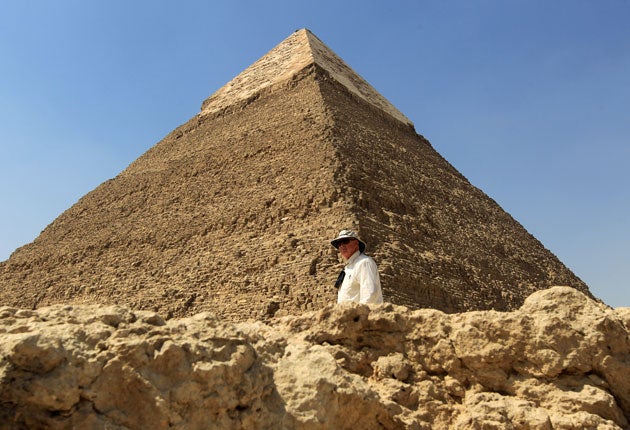Robot to explore mysterious tunnels in Great Pyramid
For 4,500 years, no one has known what lies beyond two stone doors deep inside the monument

For 4,500 years, the Great Pyramid at Giza has enthralled, fascinated and ultimately frustrated everyone who has attempted to penetrate its secrets.
Now a robotics team from Leeds University, working with Egypt's Supreme Council of Antiquities, is preparing a machine which they hope will solve one of its enduring mysteries.
The pyramid, known as the Pyramid of Khufu after the king who built it around 2,560BC, is the only wonder of the ancient world still standing. At its heart are two rooms known as the King's Chamber and the Queen's Chamber. Two shafts rise from the King's Chamber at 45-degree angles and lead to the exterior of the monument. They are believed to be a passageway designed to fire the king's spirit into the firmament so that he can take his place among the stars.
In the Queen's Chamber, there are two further shafts, discovered in 1872. Unlike those in the King's Chamber, these do not lead to the outer face of the pyramid
No one knows what the shafts are for. In 1992, a camera sent up the shaft leading from the south wall of the Queen's Chamber discovered it was blocked after 60 metres by a limestone door with two copper handles. In 2002, a further expedition drilled through this door and revealed, 20 centimetres behind it, a second door.
"The second door is unlike the first. It looks as if it is screening or covering something," said Dr Zahi Hawass, the head of the Supreme Council who is in charge of the expedition. The north shaft bends by 45 degrees after 18 metres but, after 60 metres, is also blocked by a limestone door.
Now technicians at Leeds University are putting the finishing touches to a robot which, they hope, will follow the shaft to its end. Known as the Djedi project, after the magician whom Khufu consulted when planning the pyramid, the robot will be able to drill through the second set of doors to see what lies beyond.
Dr Robert Richardson, of the Leeds University School of Mechanical Engineering, said they would continue the expedition until they reach the end of the shafts.
"We have been working on the project for five years," he said. "We have no preconceptions. We are trying to gain evidence for other people to draw conclusions. There are two shafts. The north shaft is blocked by a limestone door and nothing has penetrated that door. With the south shaft a previous team has measured the thickness of the stone, drilled through it and put a camera through it and found there was another surface. We are going to determine how thick that is and we could drill through it. We are preparing the robot now and expect to send it up before the end of the year. It's a big question, and it's very important not to cause unnecessary damage. We will carry on until we find the answer. We hope to get all the data possible which will be sufficient to answer the questions."
Join our commenting forum
Join thought-provoking conversations, follow other Independent readers and see their replies
Comments